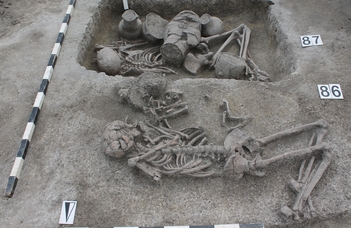Health in prehistoric Europe
According to the current view, with the start of food production (approximately 12,000 years ago), the population increased significantly, while general health conditions deteriorated to a great extent. The authors conducted an anthropological and archaeogenetic survey on the skeletal remains of 167 individuals who had lived in Europe between the Upper Palaeolithic (36,000 BC) and the Middle Iron Age (400 BC).
Since, in addition to genetic factors, environmental aspects (nutrition, starvation, common chronic illnesses) play a key role in the development of height in adulthood, a comparison of genetically determined (i.e. potentially achievable) height reconstructed from general health conditions and the actual height offer valuable information. Researchers, therefore, contrasted the height estimated on the basis of the length of bones with the potentially attainable height values based on genetic data.
The study of the bones from the periods above also covered the so-called physical stress indicators (skeletal symptoms of malnutrition and anaemia). The results suggest that
stature was distinctively shorter in the Neolithic than the genetically-estimated potential height
(by -3.82 cm on average), then started to grow in the Copper Age (by +1.95 cm compared to the Neolithic average height), and continued to increase in the Bronze Age (by +2.7 cm) and in the Iron Age (by +3.27 cm).
In Hungary, the archaeological and anthropological research as well as the taking of genetic samples were coordinated by Tamás Hajdu (Department of Anthropology, ELTE Faculty of Sciences). The archaeological background of the Hungarian series used in the analysis was offered by Viktória Kiss, Ágnes Király (Institute of Archaeology, Research Centre for the Humanities), László Domboróczki (István Dobó Castle Museum), Judit Koós and Magdolna Hellebrandt (Ottó Herman Museum), and Vajk Szeverényi (Déri Museum). The archaeological background of the Copper Age series from Urziceni/Csanalos was provided by Cristian Virag (Satu Mare County Museum/Muzeul Judetean Satu Mare, Satu Mare/Szatmárnémeti, Romania). During the research, the anthropological analysis of the Hungarian and Romanian series was carried out by Zsuzsanna K. Zoffmann (†), Kitti Köhler (Institute of Archaeology, Research Centre for the Humanities), Krisztián Kiss, Tamás Szeniczey, and Tamás Hajdu (Department of Anthropology, ELTE Faculty of Humanities).
The publication is available here.
Cover image: Urziceni/Csanalos (Romania), Copper Age, Bodrogkeresztúr culture, Urziceni (Graves 86 and 87) / Photograph by Cristian Virag (Szatmár County Museum, Romania)

